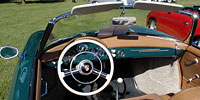 |
 |
 |
 |
Chassis # Locations |

Features of the Convertible D vs. Speedster The key differences between the Speedster and the Convertible D model were that the latter had: a redesigned and higher windshield frame, an improved top, larger rear window, glass side windows, more comfortable coupe-style seats, pockets in the door panels, and no side script, as well as other more minor changes. What follows is a detailed list: Windshield: a completely redesigned, taller windshield with a stronger frame, higher side posts and a better fit to the top assembly. Both models had windshield frames and side posts made of chrome plated brass. Overall the car was 3.5 inches taller. Top: "The tan folding steel top frame of the Convertible D evolved from the Speedster top to accept the higher windshield frame and roll-up windows. It had tubular steel construction with a steel front bow unlike the wooden bow of the cabriolet." 1 The D top frame had an additional bow than that of the Speedster's and two latches at the front similar to the Speedster's; the cabriolet had three latches. The D's top also had rain gutters added above the side roll-up windows. Rear window: a significantly enlarged rear window, even larger than the high-bow Speedster's rear window. Rear Cowl: "The rear cowl of the Speedster was considerably different than that of the cabriolet, being longer and having no recess for the tack strip. ...A new part number was noted (for the rear cowl) with the introduction of the Convertible D, due to the shape of the rear cockpit and modified top mounting." 1 Side windows: glass side windows with wind-up mechanisms, instead of side curtains, were added to the Convertible D. The doors themselves were essentially the same. Door pockets: added to the D on both interior door panels. A lockable flap with a key was optional on driver's side. As production continued, the driver's side lockable flap became more standard. The passenger's side had either the plain pocket or the optional pocket with the locking flap. The key opened either flap and was usable on any Convertible D. Seats: coupe-style non-reclining seats (recliners optional on one or both) instead of the minimally padded Speedster seats. Also headrests were an available option on the driver's seat and the headrest on the passenger's seat could be added as well. Top Boots & Tonneaus: Speedsters were equipped with a vinyl half-tonneau; vinyl full tonneaus could be ordered. Convertible Ds came standard with a vinyl boot cover for the folding top (unlike a half-tonneau, it did not cover the rear area behind the seats). A vinyl tonneau cover could be ordered as an option for the D. Scripts, badges and moldings: the "Speedster" script was no longer used on the Convertible D — the first prototype D had the script "Speedster D" on the front left fender but the production models did not. Convertible Ds were given the Drauz coachbuilder's badge on the lower right fender. Aluminum upper side moldings, pretty much standard on the Speedster, were continued into the Convertible D model run, however this could be deleted as an option. Engines: out of the 4,145 Speedsters built, 151 were originally equipped with four-cam Carrera engines. Only 2 Convertible Ds were equipped with four-cam engines out of 1,330 built. Either the 1600 Normal "Damen" (Type 616/1) or the 1600 Super (Type 616/2) engines were typically placed in the Convertible D. Minor changes: windshield washers became standard equipment, the wiper arms were changed, and the rear view mirror was slightly larger, mounted differently to the mirror support rod, and the dash had provisions for installing an ashtray and even a radio slung below the dash. All in all, the Convertible D was a somewhat more practical car than the Speedster: a larger windshield, real side windows, and more comfortable seats, while retaining the beautiful body lines and downward sloping beltline that now attracts so many 356 enthusiasts. Of course some of the minimalist, racier features of the Speedster were lost, and many Porsche purists complained long and loud in 1958! On July 31, 1958, Porsche sent a letter to dealers announcing the new "Convertible D" model and specifying the differences.
1. Johnson, Dr. Brett, The 356 Porsche, A Restorer's Guide to Authenticity, Revised Edition, (Beeman Jorgensen, Inc., 1997), pg. 36. 2. Ibid., pg. 39. |
||||||||